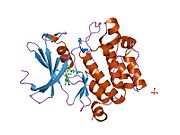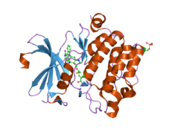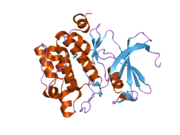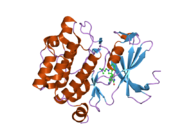PIM1
Ensembl | |||||||||
|---|---|---|---|---|---|---|---|---|---|
| UniProt | |||||||||
| RefSeq (mRNA) | |||||||||
| RefSeq (protein) | |||||||||
| Location (UCSC) | Chr 6: 37.17 – 37.18 Mb | Chr 17: 29.71 – 29.72 Mb | |||||||
| PubMed search | [3] | [4] | |||||||
| View/Edit Human | View/Edit Mouse |
Proto-oncogene serine/threonine-protein kinase Pim-1 is an enzyme that in humans is encoded by the PIM1 gene.[5][6][7]
Pim-1 is a
Gene
Located on chromosome 6 (6p21.2), the gene encompasses 5Kb of DNA, including 6 exons and 5 introns. Expression of Pim-1 has been shown to be regulated by the
Protein structure
Human, murine and rat Pim-1 contain 313 amino acids, and have a 94 – 97% amino acid identity.[8] The active site of the protein, ranging from amino acids 38-290, is composed of several conserved motifs, including a glycine loop motif, a phosphate binding site and a proton acceptor site.[8] Modification of the protein at amino acid 67 (lysine to methionine) results in the inactivation of the kinase.[8]
Activation and stabilization
Pim-1 is primarily involved in
Although little is known about the post-transcriptional modifications of Pim-1, it has been hypothesized that Hsp90 is responsible for the folding and stabilization of Pim-1, although the exact mechanism has yet to be discovered.[8] Furthermore, the serine/threonine phosphatase PP2 has been shown to degrade Pim-1.
Interactions
PIM1 has been shown to
- CBX3,[12]
- CDC25A,[13]
- Heat shock protein 90kDa alpha (cytosolic), member A1,[14]
- NFATC1,[15]
- Nuclear mitotic apparatus protein 1,[16]
- P21,[17]
- SND1[18] and
- RELA.[19]
Other known substrates/binding partners of Pim-1 include proteins involved in transcription regulation (nuclear adaptor protein p100, HP-1, PAP-1 and TRAF2 / SNX6), and regulation of the JAK/STAT pathway (SOCS1 and SOCS3).[8] Furthermore, Pim-1 has been shown to be a cofactor for c-Myc, a transcription factor believed to regulate 15% of all genes, and their synergy has been in prostate tumorigenesis.[20]
Pim-1 is able to phosphorylate many targets, including itself. Many of its targets are involved in cell cycle regulation.
Activates
- Cdc25C (G1/S positive regulator): Activation results in increased G1 → S[8]
- Cdc25C (G2/M positive regulator): Activation results in increased G2 → M[8]
Deactivates
- Bad (Pro-apoptotic protein): Deactivation results in increased cell survival[8]
- CKI (G1/S negative regulator): Deactivation results in increased G1 → S[8]
- C-TAK1 (Cdc25C inhibitor): Deactivation results in increased G2 → M[8]
Clinical implications
Pim-1 is directly involved in the regulation of cell cycle progression and apoptosis, and has been implicated in numerous cancers including prostate cancer, Burkitt's lymphoma and oral cancer, as well as numerous hematopoietic lymphomas. Single nucleotide polymorphisms in the Pim-1 gene have been associated with increased risk for lung cancer in Korean patients, and have also been found in diffuse large cell lymphomas.[21] As well as showing useful activity against a range of cancers,[11] PIM kinase inhibitors have also been suggested as possible treatments for Alzheimer's disease.[22] PIM expression is sufficient to drive resistance to anti-angiogenic agents in prostate and colon cancer models, although the mechanism is not fully elucidated.[23] It has been suggested that a co-targeted therapeutic approach to inhibition of Pim-1 in cancer may be preferable, with suggested co-targets including the PI3K pathway and more.[10] PIM1 expression was found to be elevated during aging and to contribute to the development of pulmonary fibrosis.[24]
Inhibitors
A large number of small molecule inhibitors of PIM1 have been developed. Clinical trial results so far have showed promising anti-cancer activity, but side effects due to insufficient selectivity have proved problematic and research continues to find more potent and selective inhibitors for this target.[25][26][27][28][29][30][31][10][11]
- Examples
References
- ^ a b c GRCh38: Ensembl release 89: ENSG00000137193 – Ensembl, May 2017
- ^ a b c GRCm38: Ensembl release 89: ENSMUSG00000024014 – Ensembl, May 2017
- ^ "Human PubMed Reference:". National Center for Biotechnology Information, U.S. National Library of Medicine.
- ^ "Mouse PubMed Reference:". National Center for Biotechnology Information, U.S. National Library of Medicine.
- ^ "Entrez Gene: PIM1 pim-1 oncogene".
- PMID 3329709.
- PMID 3329711.
- ^ PMID 15694833.
- ^ "Pim-1 Oncogene". Retrieved 2015-12-14.
- ^ PMID 32025342.
- ^ S2CID 209357486.
- S2CID 29392124.
- PMID 10373478.
- PMID 11237709.
- PMID 11823475.
- S2CID 26016943.
- PMID 12431783.
- PMID 9809063.
- PMID 19911008.
- PMID 20140016.
- PMID 19688129.
- PMID 27412291.
- PMID 29084916.
- PMID 35167499.
- S2CID 19401237.
- S2CID 26602099.
- PMID 24953177.
- S2CID 2331769.
- PMID 26186558.
- PMID 25582332.
- PMID 26893828.
- PMID 24363397.
- PMID 26505898.
- PMID 19825806.
- PMID 21628411.
- PMID 24953177.
Further reading
- Ragoussis J, Senger G, Mockridge I, et al. (November 1992). "A testis-expressed Zn finger gene (ZNF76) in human 6p21.3 centromeric to the MHC is closely linked to the human homolog of the t-complex gene tcp-11". Genomics. 14 (3): 673–9. PMID 1427894.
- Saris CJ, Domen J, Berns A (March 1991). "The pim-1 oncogene encodes two related protein-serine/threonine kinases by alternative initiation at AUG and CUG". The EMBO Journal. 10 (3): 655–64. PMID 1825810.
- Reeves R, Spies GA, Kiefer M, et al. (June 1990). "Primary structure of the putative human oncogene, pim-1". Gene. 90 (2): 303–7. PMID 2205533.
- Amson R, Sigaux F, Przedborski S, et al. (November 1989). "The human protooncogene product p33pim is expressed during fetal hematopoiesis and in diverse leukemias". Proceedings of the National Academy of Sciences of the United States of America. 86 (22): 8857–61. PMID 2682662.
- Telerman A, Amson R, Zakut-Houri R, et al. (April 1988). "Identification of the human pim-1 gene product as a 33-kilodalton cytoplasmic protein with tyrosine kinase activity". Molecular and Cellular Biology. 8 (4): 1498–503. PMID 2837645.
- Meeker TC, Nagarajan L, ar-Rushdi A, et al. (October 1987). "Cloning and characterization of the human PIM-1 gene: a putative oncogene related to the protein kinases". Journal of Cellular Biochemistry. 35 (2): 105–12. S2CID 43495337.
- Zakut-Houri R, Hazum S, Givol D, et al. (1987). "The cDNA sequence and gene analysis of the human pim oncogene". Gene. 54 (1): 105–11. PMID 3475233.
- Leverson JD, Koskinen PJ, Orrico FC, et al. (October 1998). "Pim-1 kinase and p100 cooperate to enhance c-Myb activity". Molecular Cell. 2 (4): 417–25. PMID 9809063.
- Mochizuki T, Kitanaka C, Noguchi K, et al. (June 1999). "Physical and functional interactions between Pim-1 kinase and Cdc25A phosphatase. Implications for the Pim-1-mediated activation of the c-Myc signaling pathway". The Journal of Biological Chemistry. 274 (26): 18659–66. PMID 10373478.
- Koike N, Maita H, Taira T, et al. (February 2000). "Identification of heterochromatin protein 1 (HP1) as a phosphorylation target by Pim-1 kinase and the effect of phosphorylation on the transcriptional repression function of HP1(1)". FEBS Letters. 467 (1): 17–21. S2CID 29392124.
- Maita H, Harada Y, Nagakubo D, et al. (August 2000). "PAP-1, a novel target protein of phosphorylation by pim-1 kinase". European Journal of Biochemistry. 267 (16): 5168–78. PMID 10931201.
- Mizuno K, Shirogane T, Shinohara A, et al. (March 2001). "Regulation of Pim-1 by Hsp90". Biochemical and Biophysical Research Communications. 281 (3): 663–9. PMID 11237709.
- Parks WT, Frank DB, Huff C, et al. (June 2001). "Sorting nexin 6, a novel SNX, interacts with the transforming growth factor-beta family of receptor serine-threonine kinases". The Journal of Biological Chemistry. 276 (22): 19332–9. PMID 11279102.
- Wang Z, Bhattacharya N, Meyer MK, et al. (June 2001). "Pim-1 negatively regulates the activity of PTP-U2S phosphatase and influences terminal differentiation and apoptosis of monoblastoid leukemia cells". Archives of Biochemistry and Biophysics. 390 (1): 9–18. PMID 11368509.
- Pasqualucci L, Neumeister P, Goossens T, et al. (July 2001). "Hypermutation of multiple proto-oncogenes in B-cell diffuse large-cell lymphomas". Nature. 412 (6844): 341–6. S2CID 4373198.
- Ishibashi Y, Maita H, Yano M, et al. (September 2001). "Pim-1 translocates sorting nexin 6/TRAF4-associated factor 2 from cytoplasm to nucleus". FEBS Letters. 506 (1): 33–8. S2CID 40248629.
- Rainio EM, Sandholm J, Koskinen PJ (February 2002). "Cutting edge: Transcriptional activity of NFATc1 is enhanced by the Pim-1 kinase". Journal of Immunology. 168 (4): 1524–7. PMID 11823475.
- Nieborowska-Skorska M, Hoser G, Kossev P, et al. (June 2002). "Complementary functions of the antiapoptotic protein A1 and serine/threonine kinase pim-1 in the BCR/ABL-mediated leukemogenesis". Blood. 99 (12): 4531–9. PMID 12036885.
- Bhattacharya N, Wang Z, Davitt C, et al. (July 2002). "Pim-1 associates with protein complexes necessary for mitosis". Chromosoma. 111 (2): 80–95. S2CID 26016943.












![1yxx: Crystal Structure of Kinase Pim1 in complex with (3E)-3-[(4-HYDROXYPHENYL)IMINO]-1H-INDOL-2(3H)-ONE](http://upload.wikimedia.org/wikipedia/commons/thumb/3/3b/PDB_1yxx_EBI.png/180px-PDB_1yxx_EBI.png)













